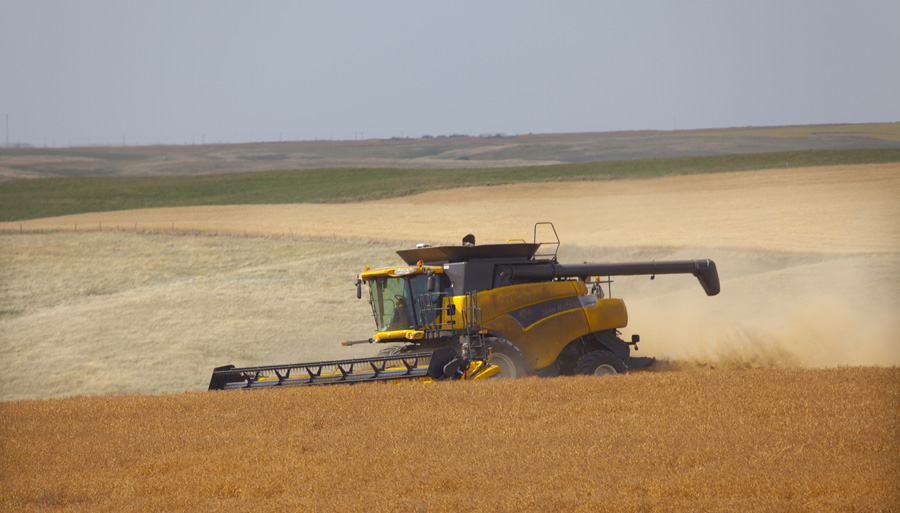September 18, 2019
With the pulse harvest well underway, GPC checked in with the Northern Pulse Growers Association.


Pulse harvest from a few years ago. Photo courtesy of the Northern Pulse Growers Association.
In the U.S., peas, lentils, chickpeas and dry beans are all coming off the fields, with harvest progress varying by pulse crop and growing area. With the exception of dry peas, the U.S. is projected to harvest smaller pulse crops this year. The lentil crop is estimated at 6.55 million cwt, a 22% decrease from 2018. The chickpea crop is forecast at 7.17 million cwt, a 44% decrease from a year ago. The dry bean crop is anticipated to come in at nearly 24.6 million cwt, which is slightly less (0.7%) than last year. Pea production, on the other hand, is estimated to be up 44% to 22.3 million cwt.
To see how harvest is coming along, GPC checked in with Shannon Berndt, executive director of the Northern Pulse Growers Association, representing pulse growers in the states of Montana and North Dakota, two states that contribute a large share of U.S. pulse production.
“We are into our third consecutive day of rain,” she said when reached at her office in Bismarck, North Dakota on September 12th. “There has been some significant flooding, especially in South Dakota, from this weather system that is moving through.”
Western North Dakota was a mere tenth of an inch from setting a new precipitation record for the month of September. “And we’re just two weeks in!” said Berndt.
In her estimation, it will likely be at least a week before growers are able to get back in the fields to assess crop damage and resume harvesting.
Below, we take a closer look at where each pulse crop stands.
In both Montana and North Dakota, the pea crop was planted late due to rainy weather. In Montana, fields were submerged in standing water as late as late May. In North Dakota, cool and wet conditions slowed crop development.
As of September 9, the pea harvest was 90% complete in North Dakota and 89% complete in Montana. In the case of Montana, harvest progress is behind the average pace of 95% for the date. Wet conditions and hailstorms slowed the combines this harvest season. In North Dakota, Berndt believes the remaining 10% of the peas can be written off.
“I think they are going to be abandoned due to weather conditions at this point,” she said. “My guess it is just too wet to get in and actually get them off.”
Those losses, however, will be more than offset by record pea yields of 2,500 lbs./acre. The USDA estimates North Dakota’s dry pea production at 10.1 million cwt, up 26% from a year ago.
In Montana, production is estimated 8.75 million cwt, a 74% increase from last year. Yields were also up compared to 2018, but to a more modest 1,750 lbs./acre.

In North Dakota, the lentil harvest was 35% advanced as of September 9th, behind the five-year average of 85% for that date. The state is expected to reap record yields for lentils (1,600 lbs./acre), but production is expected to decrease 40% from last year on a 49% reduction in the seeded area.
In Montana, 85% of the lentil crop had been harvested as of September 9th, behind last year’s pace of 93% for that date. Despite a dramatic 64% decrease in lentil plantings, production is down a more modest 17% due to a 380-pound improvement in yields (1,460 lbs./acre this year compared to 1,080 lbs./acre last year).
Berndt is hopeful that weather conditions might improve moving forward.
“Some years, its warm enough to wear short-sleeves into November, so its hard to tell,” she says. “But at this point, as wet as it is, I would think the quality wouldn’t be very good.”

Berndt expects the chickpea harvest in the Northern Plains will be delayed significantly this year due to the wet weather. The excessive moisture also raises concerns about disease, such as ascochyta blight
In Montana, harvest progress is at 52%, behind the five-year average of 73%. Production is forecast at nearly 3.29 million cwt, a 36% decrease from a year ago. Yields are up by 370 pounds, but plantings were down considerably.
In North Dakota, production is projected at 660,000 MT, a 65% decrease from last year. The harvested area is down 64% from last year and yields are expected to drop off by 50 pounds to 1,690 lbs./acre.

Dry beans are the last of the pulse crops to come off the fields. The major classes grown in the Northern Plains are pinto, black and navy beans. As with chickpeas, disease issues are a concern given the excessively wet conditions at present.
In North Dakota, 8% of the bean crop had been harvested as of September 9th, behind the five-year average pace for that date of 28%. Seventy seven percent of the bean plants were dropping leaves, behind the five-year average of 84%. The crop rated 7% very poor to poor, 30% fair, 54% good and 9% excellent.
In Montana, the bean crop rated 2% poor, 55% fair, 35% good and 8% excellent.

Disclaimer: The opinions or views expressed in this publication are those of the authors or quoted persons. They do not purport to reflect the opinions or views of the Global Pulse Confederation or its members.